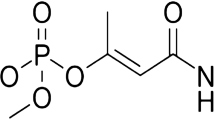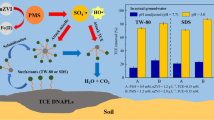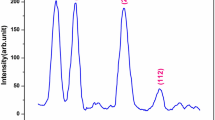Abstract
The present study focused on the degradation of mixed pesticides using UV-induced photocatalytic degradation of lindane (1α,2α,3β,4α,5α,6β-hexachlorocyclohexane), methyl parathion (O,O-dimethyl-O-4-nitrophenyl phosphorothioate), and dichlorvos (2,2-dichlorovinyl-O-O-dimethyl phosphate). Different grades of TiO2 were prepared through the acid route (AR), alcohol route (AlR), and surfactant route (SR) and their photocatalytic activity were compared with commercially available Degussa P-25 TiO2. The rate of degradation of pesticides was high for TiO2 prepared through the SR compared to the other three catalysts. The crystalline structure and morphology of SR TiO2 was identified with scanning electron microscope, energy dispersive X-ray analyzer, UV, and transmission electron microscope analyses and was compared with that of Degussa P-25 TiO2. Degradation studies of individual as well as mixed pesticides were carried out. The intermediate formed during the photodegradation of methyl parathion, lindane, and dichlorvos were identified by gas chromatography–mass spectrometry analysis.














Similar content being viewed by others
References
Adachi, M., Murata, Y., Takao, J., Jiu, J., Sakamoto, M., & Wang Highly, F. (2004). Efficient dye-sensitized solar cells with a titania thin-film electrode composed of a network structure of single-crystal-like TiO2 nanowires made by the “Oriented Attachment” mechanism. Journal of American Chemical Society, 126, 14943–14949.
Atiqur Rahman, M., & Muneer, M. (2005). Photocatalysed degradation of two selected pesticide derivatives, dichlorvos and phosphamidon, in aqueous suspensions of titanium dioxide. Desalination, 181, 161–172.
Chen, Y., & Dionysiou, D. D. (2006). TiO2 photocatalytic films on stainless steel: The role of Degussa P-25 in modified sol–gel methods. Applied Catalysis B: Environmental, 62, 255–264.
Choi, H., Stathatos, E., & Dionysiou, D. D. (2006). Synthesis of nanocrystalline photocatalytic TiO2 thin films and particles using sol–gel method modified with nonionic surfactants. Thin Solid Films, 510, 107–114.
Dionysiou, D. D., Khodadoust, A. P., Kern, A. M., Suidan, M. T., Baudin, I., & Michel Laîné, J. (2000). Continuous-mode photocatalytic degradation of chlorinated phenols and pesticides in water using a bench-scale TiO2 rotating disk reactor. Applied Catalysis B: Environmental, 24, 139–155.
Evgenidou, E., Fytianos, K., & Poulios, L. (2005). Semiconductor-sensitized photodegradation of dichlorvos in water using TiO2 and ZnO as catalysts. Applied Catalysis B: Environmental, 59, 81–89.
Evgenidou, E., Konstantinou, I., Fytianos, K., Poulios, I., & Albanis, T. (2007). Photocatalytic oxidation of methyl parathion over TiO2 and ZnO suspensions. Catalysis Today, 124, 156–162.
Gallezot, P., & Leclercq, C. (1994). Catalyst characterization: Physical techniques for solid materials. New York: Plenum. Quoted by B. Imelik & J.C. Vedrine.
Gelover, S., Mondragónb, P., & Jiménez, A. (2004). Titanium dioxide sol–gel deposited over glass and its application as a photocatalyst for water decontamination. Journal of Photochemistry and Photobiology A: Chemistry, 165, 241–246.
Guillard, C., Beaugiraud, C. D., Herrmann, J. M., Jaffrezic, H., Renault, N. J., & Lacroix, M. (2002). Physiochemical properties and photocatalytic activities of TiO2 films prepared by sol gel methods. Applied Catalyst B: Environment, 39, 331–342.
Gupta, P. K. (2004). Pesticide exposure—Indian scene. Toxicology, 198, 83–90.
Hoyer, A., Grandjean, P., Jorgensen, T., Brock, J. W., & Hartvig, H. B. (1998). Organochlorine exposure and risk of breast cancer. Lancet, 352, 1816–1820.
Jwo, C. S., Tien, D. C., Teng, T. P., Chang, H., Tsung, T. T., Liao, C. Y., et al. (2005). Preparation and UV characterization of TiO2 nanoparticles synthesized by SANSS. Review on Advanced Material Science, 10, 283–288.
Khanna, P. K., Singha, N., & Charan, S. (2007). Synthesis of nano-particles of anatase-TiO2 and preparation of its optically transparent film in PVA. Materials Letters, 61, 4725–4730.
Kim, T., Kim, J., Choi, K., Stenstrom, M. K., & Zoh, K. (2006). Degradation mechanism and the toxicity assessment in TiO2 photocatalysis and photolysis of parathion. Chemosphere, 62, 926–933.
Li, B., Wang, X., Yan, M., & Li, L. (2002). Preparation and characterization of nano-TiO2 powder. Materials Chemistry and Physics, 78, 184–188.
Li-yuan, C., Yan-fen, Y., Gang, Z., Bing, P., & Shun-wen, W. (2007). Effect of surfactants on preparation of nanometer TiO2 by pyrohydrolysis. Transactions of Nonferrous Metals Society of China, 17, 176–180.
Ma, T., Kramer, R. E., Baker, R. C., Fan, L. W., & Ho, I. K. (2003). Effects of chronic dermal exposure to nonlethal doses of methyl parathion on brain regional acetyl cholinesterase and muscarinic cholinergic receptors in female rats. Journal of Neuroscience Research, 71, 138–145.
Maldonado, M. I., Malato, S., Pérez-Estrada, L. A., Gernjak, W., Oller, I., Domenech, X., et al. (2006). Partial degradation of five pesticides and an industrial pollutant by ozonation in a pilot-plant scale reactor. Journal of Hazardous Materials, 138, 363–369.
Moctezuma, E., Leyva, E., Palestino, G., & de Lasa, H. (2007). Photocatalytic degradation of methyl parathion: reaction pathways and intermediate reaction products. Journal of Photochemistry and Photobiology A: Chemistry, 186, 71–84.
Mohammadi, M. R., Cordero-Cabrera, M. C., Fray, D. J., & Ghorbani, M. (2006). Preparation of high surface area titania (TiO2) films and powders using particulate sol–gel route aided by polymeric fugitive agents. Sensors and Actuators B: Chemical, 120, 86–95.
Prakash, O., Suar, M., Raina, V., Dogra, C., Pal, R., & Lal, R. (2004). Residues of hexachlorocyclohexane isomers in soil and water samples from Delhi and adjoining areas. Current Science, 87, 73–77.
Sakulkhaemaruethai, S., Suzuki, Y., & Yoshikawa, S. (2004). Surfactant-assisted preparation and characterization of mesoporous titania nanocrystals. Journal of the Ceramic Society of Japan, 112, 547–552.
Shang, J., Li, W., & Zhu, Y. (2003). Structure and photocatalytic characteristics of TiO2 film photocatalyst coated on stainless steel webnet. Journal of Molecular Catalysis A: Chemical, 202, 187–195.
Torimoto, T., Okawa, Y., Takeda, N., & Yoneyama, H. (1997). Effect of activated carbon content in TiO2-loaded activated carbon on photodegradation behaviors of dichloromethane. Journal of Photochemistry and Photobiology A: Chemistry, 103, 153–157.
Wang, J., Suna, W., Zhang, Z., Zhang, X., Li, R., Maa, T., et al. (2007). Sonocatalytic degradation of methyl parathion in the presence of micron-sized and nano-sized rutile titanium dioxide catalysts and comparison of their sonocatalytic abilities. Journal of Molecular Catalysis A: Chemical, 272, 84–90.
Zaleska, A., Hupka, J., Wiergowski, M., & Biziuk, M. (2004). Photocatalytic degradation of lindane, p, p DDT and methoxychlor in an aqueous environment. Journal of Photochemistry and. Photobiology A: Chemistry, 135, 213–220.
Zhang, Q., Gao, L., & Guo, J. (2000). Effects of calcination on the photocatalytic properties of nanosized TiO2 powders prepared by TiCl4 hydrolysis. Applied Catalysis B: Environmental, 26, 207–215.
Zhang, X., Hong Pan, J., Du Jianhong, A., Ng, J., Darren, D., Sun, J., et al. (2009). Fabrication and photocatalytic activity of porous TiO2 nanowire microspheres by surfactant-mediated spray drying process. Materials Research Bulletin, 44, 1070–1076.
Author information
Authors and Affiliations
Corresponding author
Rights and permissions
About this article
Cite this article
Senthilnathan, J., Philip, L. Removal of Mixed Pesticides from Drinking Water System Using Surfactant-Assisted Nano-TiO2 . Water Air Soil Pollut 210, 143–154 (2010). https://doi.org/10.1007/s11270-009-0230-6
Received:
Accepted:
Published:
Issue Date:
DOI: https://doi.org/10.1007/s11270-009-0230-6




